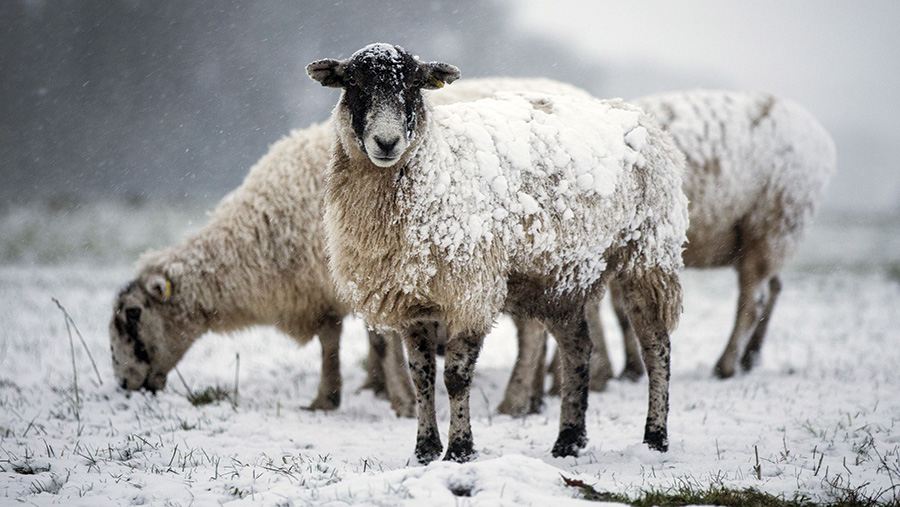5 steps to managing your flock’s forage at winter
 © Andrew Mccaren/LNP/Shutterstock
© Andrew Mccaren/LNP/Shutterstock Sheep producers should have a strategy in place to maximise forage over winter, especially following a trend for high energy (>11MJ ME/kg DM) silages.
This is the advice of SAC Consulting sheep specialist Poppy Frater who advises regular body condition scoring to assess how flocks are coping after a tough autumn.
She outlines five steps to maximise forage use for a cost-effective winter feeding period.
See also: All you need to know about feeding sheep a total mixed ration
1 Regular body condition scoring (BCS)
- Body condition score sheep monthly. This allows you to target the best grazing at the thinner ewes that need it and save on quality silage for late gestation.
- Some farmers condition score every three to four weeks and very keen farmers do it fortnightly.
- Latest research (AHDB, Feeding the Ewe PDF) shows that ewes should be maintained at target BCS for 90 days from tupping to help fertilisation, implantation and placenta development.
Targets
- Lowland ewe (60-80kg) BCS 3-3.5. Hill ewe (40-60kg) BCS 2.5 from tupping to scanning.
2 Cut costs by maximising good quality silage and grass
- Have silages analysed to determine which is the best you have and feed that silage at the last five to six weeks of gestation.
- Hay or bulk cut of silage/haylege can maintain ewes through mid-pregnancy until the last five to six weeks when udder development, colostrum production and foetal growth increase.
Targets
- If you are feeding concentrates in late gestation, plan on feeding no more than 0.5kg a head/day in two feeds to avoid ruminal acidosis.
- If you’ve made a silage of 10.5ME, speak with a vet or nutritionist about how to balance the ration to save on hard feed. Silages of 11-12ME and 12CP can simply be supplemented with soya-based bypass (rumen undegradable protein) products at 100g a lamb carried/day.
3 Ensure there is a Plan B
- Train hoggs to eat hard feed now. This works best if on stubbles or in small paddocks.
- Have a stock of three weeks’ ‘storm feed’ to place in the snacker or troughs.
Targets
- 100 pre-scanning ewes will need 12 x 270kg bales of 87%DM hay for three weeks. 100-post scanning ewes will need 27 x 650kg bales of 30%DM silage. (These are rough calculations based on a 65kg ewe accounting for 30% wastage.)
4 Take care of soils and grassland
- Ensure you close off fields ready for the spring, giving 90-120 days rest.
- A field you graze in mid-December shouldn’t be grazed again until early April, giving 120 days rest.
- If your system requires bales to be put out, do this in advance when fields are dry or when ground frost permits easy trafficking to reduce compaction and poaching.
- Wet weather means rotational grazers should stock at higher densities but for less time, reducing the amount of time spent on each paddock.
Targets
- Aim to have closed off 80% of the grazing platform for a 90-120-day rest period by mid-December.
- Close paddocks at 3-4cm (1,200-1,500kgDM/ha) to ensure cost-effective nutrition for the ewe in the spring when her demands are higher.
- An 80kg twin-bearing ewe requires about 12.6mJ a day seven weeks pre-lambing, which increases to 20.2MJ a week prior to lambing and 30-32MJ in the first week of lactation.
5 Metabolic profiling: Get the timing right
- Ration ewes to the forage you have and ensure good productivity, colostrum production, strong lambs and low neonatal mortality. It can be useful to have bloods analysed for beta-hydroxybutyrate (BOHB).
- BOHB is produced when fat is broken down, a sign the sheep is short of energy.
- SAC labs test for BOHB and urea, which indicates protein intake and costs £38.85 for 10 animals. Eight animals from each management group is often advised.
- A test for BOHB, urea, albumin, magnesium and copper is available from Royal (Dick) School of Veterinary Studies for £150 for 1-20 animals.
Targets
- Mark the lambing date in the diary, work back three to four weeks prior to that date, and consider having tests done then. This allows time to correct rations while being representative of rising energy demands in late gestation.
